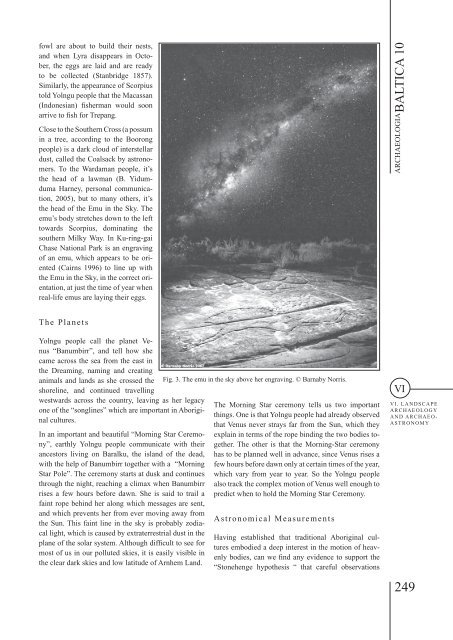BALTICA10
BALTICA10
BALTICA10
You also want an ePaper? Increase the reach of your titles
YUMPU automatically turns print PDFs into web optimized ePapers that Google loves.
fowl are about to build their nests,<br />
and when Lyra disappears in October,<br />
the eggs are laid and are ready<br />
to be collected (Stanbridge 1857).<br />
Similarly, the appearance of Scorpius<br />
told Yolngu people that the Macassan<br />
(Indonesian) fisherman would soon<br />
arrive to fish for Trepang.<br />
Close to the Southern Cross (a possum<br />
in a tree, according to the Boorong<br />
people) is a dark cloud of interstellar<br />
dust, called the Coalsack by astronomers.<br />
To the Wardaman people, it’s<br />
the head of a lawman (B. Yidumduma<br />
Harney, personal communication,<br />
2005), but to many others, it’s<br />
the head of the Emu in the Sky. The<br />
emu’s body stretches down to the left<br />
towards Scorpius, dominating the<br />
southern Milky Way. In Ku-ring-gai<br />
Chase National Park is an engraving<br />
of an emu, which appears to be oriented<br />
(Cairns 1996) to line up with<br />
the Emu in the Sky, in the correct orientation,<br />
at just the time of year when<br />
real-life emus are laying their eggs.<br />
ARCHAEOLOGIA BALTICA 10<br />
The Planets<br />
Yolngu people call the planet Venus<br />
“Banumbirr”, and tell how she<br />
came across the sea from the east in<br />
the Dreaming, naming and creating<br />
animals and lands as she crossed the<br />
shoreline, and continued travelling<br />
westwards across the country, leaving as her legacy<br />
one of the “songlines” which are important in Aboriginal<br />
cultures.<br />
In an important and beautiful “Morning Star Ceremony”,<br />
earthly Yolngu people communicate with their<br />
ancestors living on Baralku, the island of the dead,<br />
with the help of Banumbirr together with a “Morning<br />
Star Pole”. The ceremony starts at dusk and continues<br />
through the night, reaching a climax when Banumbirr<br />
rises a few hours before dawn. She is said to trail a<br />
faint rope behind her along which messages are sent,<br />
and which prevents her from ever moving away from<br />
the Sun. This faint line in the sky is probably zodiacal<br />
light, which is caused by extraterrestrial dust in the<br />
plane of the solar system. Although difficult to see for<br />
most of us in our polluted skies, it is easily visible in<br />
the clear dark skies and low latitude of Arnhem Land.<br />
Fig. 3. The emu in the sky above her engraving. © Barnaby Norris.<br />
The Morning Star ceremony tells us two important<br />
things. One is that Yolngu people had already observed<br />
that Venus never strays far from the Sun, which they<br />
explain in terms of the rope binding the two bodies together.<br />
The other is that the Morning-Star ceremony<br />
has to be planned well in advance, since Venus rises a<br />
few hours before dawn only at certain times of the year,<br />
which vary from year to year. So the Yolngu people<br />
also track the complex motion of Venus well enough to<br />
predict when to hold the Morning Star Ceremony.<br />
Astronomical Measurements<br />
Having established that traditional Aboriginal cultures<br />
embodied a deep interest in the motion of heavenly<br />
bodies, can we find any evidence to support the<br />
“Stonehenge hypothesis “ that careful observations<br />
VI<br />
VI. LANDSCAPE<br />
ARCHAEOLOGY<br />
AND ARCHAEO-<br />
ASTRONOMY<br />
249
















